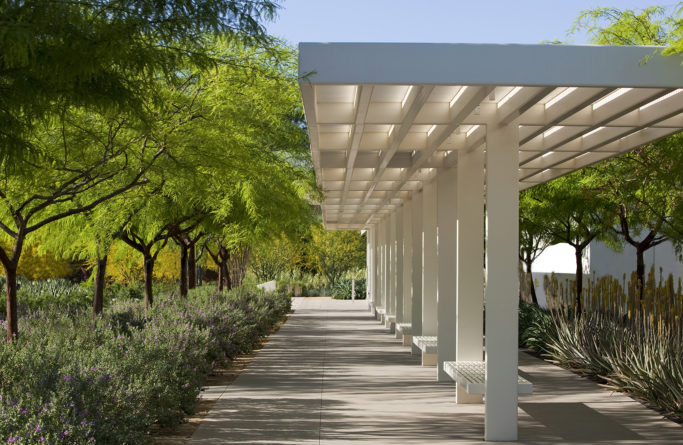REFLECTING ON THE PAST – SUNNYLANDS’ NEW VISITOR CENTER MIRRORS THE FEEL OF THE ORIGINAL ESTATE
The huge glass wall disappears as you gaze out at the formal gardens and, in the distance, the majestic San Jacinto Mountains. Nine acres of agave, cacti, and wild grasses hint at the sustainable practices found throughout the grounds of the Annenberg Retreat at Sunnylands.The only object standing before this view is a late Alberto Giacometti sculpture, Bust of Diego, engulfed by the desert garden in blazing sunlight.
Despite the expansive floor area, high ceiling, and austere simplicity in decor, the surrounding room feels like a large living room. In the center are chairs and couches selected by Michael Smith, the interior designer for Sunnylands visitor center.The mood of the new building accords with the wishes of Leonore Annenberg, who commissioned Los Angeles architect Fred Fisher to create a building with the feeling of a house. That modesty of intention seems right for a structure that will serve, in part, as a kind of anteroom to the landmark Annenberg estate, which opens to the public as a historic house and retreat center in November.Although Mrs. Annenberg, who died in 2009, did not live to see the finished building, Fisher complied faithfully with her wishes.
“This is a straightforward, domestic-type building,” he says. “The materials are wood, plaster, and glass, which are home-building materials.”While the new building is a distinguished addition to Sunnylands, Fisher and Smith have consciously made the new building modest, so as not to compete with the star attraction: the original estate designed by midcentury master A. Quincy Jones. The all-white house, with a flattened pyramid for a roof, is a masterpiece of midcentury modernism in the Coachella Valley, as well as a high-water mark for the architect, who died in 1979.Fisher emphasizes that he wants a clear distinction between Jones’ work and his own. The visitor center, he notes, is “clearly a new building of a new era.” In this deferential approach to design, Fisher joins the group of contemporary architects who have grappled with the problem of creating a new structure near a landmark building. Even the pink concrete block that he selected for walls at the entrance gates must be clearly distinguishable from the pink walls that enclose the Annenberg estate and its vast manicured lawn.Fisher also is renovating the residence. Architectural historian David DeLong recalls that Walter Annenberg, ushering Queen Elizabeth into his house, told her she was going to “see how ordinary Americans live.” DeLong points out that the Annenberg estate is not very different in form or spirit from hundreds of single-story houses in the Coachella Valley. Long, low-lying, and modestly fitting into a landscape of green grass, the estate is intended for informal living and comfort, not for advertising wealth or projecting an image of power. Fisher calls his renovation modest and respectful. His work is limited to replacing the original roof and replacing all windows with safety glass.Among its other roles, the new building demonstrates green building practices. An array of solar panels is expected to supply nearly all the power to the visitor center. The use of recycled materials, such as the terrazzo flooring, helps qualify the building for a LEED Gold rating.
Fisher was introduced to Leonore Annenberg by her daughter. As luck would have it, he was arguably the architect most qualified to work in the shadow of A. Quincy Jones: He has restored three Jones houses (including Jones’ own house, known as “the Barn”) and installed his own design studio in Jones’ former office. Fisher says his new building renders homage to Jones in several ways: the use of lava rock, the commitment to clear-cut modernism, and the indoor-outdoor sensibility of California culture.The deep horizontal roof of the new building is another nod to the earlier architect, according to Fisher. “Roofs were important to Jones, as you can see in the pyramidal roof in the estate,” he says.In keeping with the landscape-centric residence (“Essentially, it’s a house on a golf course,” Fisher says), the architect insisted on a unified approach to the design of the visitor center and gardens created by landscape architect James Burnett of Solana Beach and Houston. It’s that focus on surroundings that bring an even greater grandeur to the Annenberg Retreat at Sunnylands.
Read more on Palm Springs Life.
